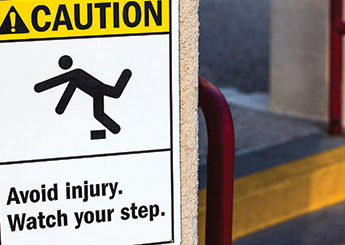Preventing slips, trips and falls

A slip, trip or fall at work can lead to injuries – and even death. In 2013, injuries from slips, trips and falls resulted in 229,190 cases involving days away from work, and 724 workers died, according to the 2016 edition of the National Safety Council chartbook “Injury Facts.”
These sobering statistics are a stark reminder that workers need to know how to prevent slips, trips and falls. Here, the Canadian Center for Occupational Health and Safety explains the differences between slips and trips, and offers advice on how to prevent falls and stay safe.
Slips and trips
Slips happen when there isn’t enough friction or traction between your feet and the surface you’re walking on. Common causes of slips include wet or oily floors, spills, loose or unanchored mats, and flooring that lacks the same degree of traction in all areas, CCOHS states.
Trips happen when your foot strikes an object, causing you to lose your balance. Workers trip due to a variety of reasons, including clutter in walkways, poor lighting, uncovered cables, drawers being left open and wrinkled carpeting or rugs.
To help prevent slips and trips, CCOHS recommends the following:
- Clean up spills immediately. If a spill can’t be cleaned up right away, place “wet floor” warning signs for workers.
- Keeps walkways and hallways free of debris, clutter and obstacles.
- Keep filing cabinets and desk drawers shut when not in use.
- Cover cables or cords in walkways.
- Replace burnt-out light bulbs promptly.
- Consider installing abrasive floor mats or replacing worn flooring.
- Encourage workers to wear comfortable, properly fitted shoes.
Falls
The Centers for Disease Control and Prevention states that falls can happen in all occupational settings, and “circumstances associated with fall incidents in the work environment frequently involve slippery, cluttered or unstable walking/working surfaces; unprotected edges; floor holes and wall openings; unsafely positioned ladders; and misused fall protection.”
To reduce the risk of falling at work, CCOHS recommends paying attention to your surroundings and walking at a pace that’s suitable for the surface you’re on and the task you’re performing. Additionally, walk with your feet pointed slightly outward, make wide turns when walking around corners and use the handrails on stairs.
Post a comment to this article
Safety+Health welcomes comments that promote respectful dialogue. Please stay on topic. Comments that contain personal attacks, profanity or abusive language – or those aggressively promoting products or services – will be removed. We reserve the right to determine which comments violate our comment policy. (Anonymous comments are welcome; merely skip the “name” field in the comment box. An email address is required but will not be included with your comment.)

